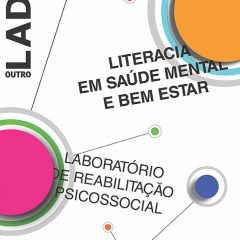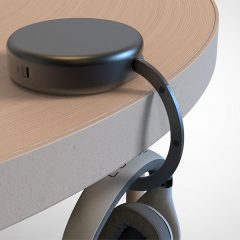Autoria
Sara Filipa Lourenço Trindade
Orientador
Abel Tavares
Marta Fernandes
Ano
2021
Curso
Mestrado em Design
Resumo
PT
O presente trabalho de projeto reflete uma investigação e processo de design intenso entre a relação forma/função no design num contexto inclusivo. Percebe-se que o design é um refletor de várias soluções para diferentes contextos com interações variadas, quer em contexto individual ou coletivo. Um objeto pode apresentar uma capacidade de pertença e representatividade numa sociedade, onde uma simples porta automática consegue ser utilizada por todos os indivíduos sem qualquer imposição; outras vezes o design consegue transmitir um bem-estar ou tranquilidade, como o uso confortável de uma cadeira ao escrever uma dissertação; consegue também refletir personalidade de algo ou alguém através da forma áspera da sua superfície; consegue ainda abrir mundos e oportunidades a um simples toque interativo que cria possibilidades infinitas; e por fim consegue refletir e impor sentimentos de desejo, motivação e felicidade no seu utilizador. Reconhece-se que estas condições funcionam a um nível individual onde o próprio utilizador cria e desenha o seu mundo, contudo surge a questão de quando este não têm poder de escolha na sua opção. Quando a sua atividade de vida está limitada pelas imposições da normalidade pré-estipulada pela sociedade em que vive, que apesar de reconhecer as suas necessidades não lhes atribui o valor digno e desejado. Este é o dia-a-dia de uma pessoa com qualquer tipo de dificuldade motora, cognitiva ou psicológica, temporária ou permanente, que necessita de adaptar e minimizar as suas aspirações devido a falta de soluções realistas. Apesar do ambiente ao nosso redor avançar todos os dias na procura de soluções mais inovadoras e tecnológicas, estas não representam a real normalidade, desta forma nascem estereótipos. Estes, não resolvidos, acabam por tingir o pensamento universal e utópico do futuro da humanidade. Existem variadas situações onde o utilizador necessita do auxílio de um designer, para perceber as verdadeiras circunstâncias e dificuldades da sua realidade. O presente projeto insere-se na realidade de pessoas que sobreviveram a um AVC e que ficaram com sequelas físicas, necessitando deste modo de restabelecer a comunicação entre a sua atividade física e cognitiva. O tempo e a qualidade da recuperação destas pessoas dependem da situação e motivação de cada indivíduo, pelo que qualquer solução ou tratamento deve focar-se nas necessidades de cada um. Se o foco se redirecionar para as necessidades reais do indivíduo e não nas capacidades generalizadas, assumidas pela sociedade ou até pelo designer, consegue-se projetar para um leque de pessoas que partilham uma necessidade semelhante ou que beneficiarão do mesmo objeto no seu quotidiano. A presente investigação procurou estudar: os princípios fundamentais do design de produto; as origens e evolução do design inclusivo e quais os fatores éticos corretos a serem considerados; a perspetiva tecnológica futura na medicina e reabilitação médica. Todas estas intervenções resultaram numa proposta de design de um conjunto de objetos para reabilitação em contexto doméstico.
EN
The present project work reflects an intense investigation and design process between the relation form / function in design in an inclusive context. It is noticed that the design is a reflector of several solutions for different contexts with varied interactions, whether in individual or collective context. An object can have the capacity of representation and belonging in a society, where a simple automatic door can be used by all individuals without any imposition; other times, the design can convey a well-being or tranquillity, such as the use of a comfortable chair when writing a dissertation; it can also reflect the personality of something or someone through the rough shape of its surface; it can also manage to open worlds and opportunities to a simple interactive touch that creates infinite possibilities; and finally it can reflect and impose feelings of desire, motivation and happiness on its user. It is recognized that these conditions work at an individual level where the user himself creates and designs his world, however the question arises when he has no choice in his choice. When their life activity is limited by the impositions of pre-stipulated normality by the society in which they live, which despite recognizing their needs does not give them the dignified and desired value. This is the daily life of a person with any type of motor, cognitive or psychological difficulty, temporary or permanent, who needs to adapt and minimize their aspirations due to the lack of realistic solutions. Although the environment around us advances every day in the search for more innovative and technological solutions, these do not represent the real normality, thus stereotypes are born. These, unresolved, end up tinting the universal and utopian thinking of the future of humanity. There are several situations where the user needs the help of a designer, to understand the real circumstances and difficulties of their reality. The present project is placed in the reality of people who survived a stroke and were left with physical after side-effects, thus the need to re-establish the communication between their physical and cognitive activity. The time and quality of recovery of these people depends on the situation and motivation of each individual, so, any solution or treatment must focus on the needs of each one. If the focus is redirected to the real needs of the individual and not to the generalized capacities assumed by society or even by the designer, it is possible to design for a spectrum of people who share a similar need or people that will benefit from the same object in their daily lives. The present investigation sought to study: the fundamental principles of product design; the origins and evolution of inclusive design and what are the correct ethical factors to be considered; the future technological perspective in medicine and medical rehabilitation. All these interventions resulted in a proposal to design a set of objects for rehabilitation to be used in the domestic context.































